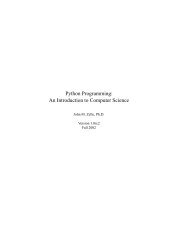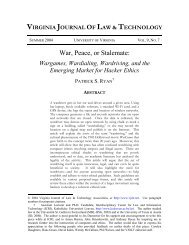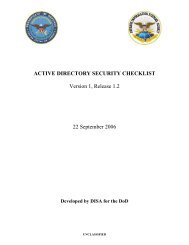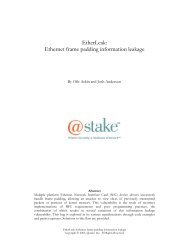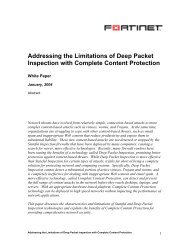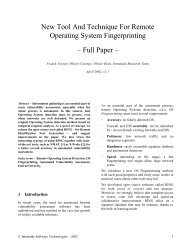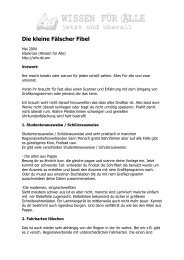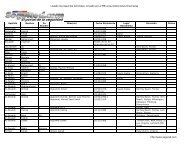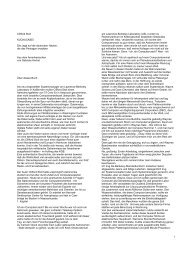Firewall Evolution - Deep Packet Inspection - Leet Upload
Firewall Evolution - Deep Packet Inspection - Leet Upload
Firewall Evolution - Deep Packet Inspection - Leet Upload
Create successful ePaper yourself
Turn your PDF publications into a flip-book with our unique Google optimized e-Paper software.
SecurityFocus HOME Infocus: <strong>Firewall</strong> <strong>Evolution</strong> - <strong>Deep</strong> <strong>Packet</strong> <strong>Inspection</strong><br />
<strong>Firewall</strong> <strong>Evolution</strong> - <strong>Deep</strong> <strong>Packet</strong> <strong>Inspection</strong><br />
by Ido Dubrawsky<br />
last updated July 29, 2003<br />
<strong>Firewall</strong>s provide a variety of services to networks in terms of security. They provide for network address tr<br />
networks (VPN), and filtering of traffic that does not conform to the network's stated security policy. There<br />
simple packet filters to circuit-level gateways to proxy firewalls. <strong>Firewall</strong>s are being asked to fill a larger and<br />
security these days than several years ago. One of the more recent innovations in firewall technology is the<br />
inspection or DPI. <strong>Deep</strong> <strong>Packet</strong> <strong>Inspection</strong> can be seen as the integration of Intrusion Detection (IDS) and I<br />
capabilities with traditional stateful firewall technology. Traditional networks have a defined boundary dema<br />
sensor sitting behind it.<br />
One of the primary benefits of the traditional firewall/IDS deployment is that the failure of one component<br />
completely unprotected. Also, IDS appliances can be deployed throughout the LAN and monitor traffic insid<br />
boundary areas between networks. This design is illustrated in Figure 1 below. The IDS monitors traffic tha<br />
defined in the firewall policy) and inspects packets for malicious activity.<br />
Figure 1 - Traditional <strong>Firewall</strong> Deployment Design<br />
With <strong>Deep</strong> <strong>Packet</strong> <strong>Inspection</strong> firewalls the IDS collapses into the firewall such that the firewall provides for i<br />
eliminates an additional piece of network equipment which can fail while increasing the capabilities inheren<br />
cover one particular form (and function) of firewalls -- stateful firewalls and how deep packet inspection pro<br />
these firewalls than ever before.<br />
Stateful <strong>Firewall</strong>s -- An Overview<br />
In the early stages of firewalls all traffic had to be explicitly specified whether it was permitted. A good exa<br />
firewall was the original Linux firewall. This firewall (whether manipulated with ipfwadm or ipchains require<br />
firewall (regardless of direction) be specified. The firewall did not keep track of the various sessions that m<br />
firewall.<br />
Stateful inspection changed all that. Invented by Check Point Software Technologies in the mid-to-late 199<br />
became an industry standard. Stateful inspection provides for the analysis of packets at the network layer a<br />
transport layer in the OSI model but the firewall may look at layers above that as well) in order to assess t<br />
information from various layers (transport, session, and network) the firewall is better able to understand t<br />
also provides for the ability to create virtual sessions in order to track connectionless protocols such as UDP<br />
RPC-based applications.<br />
Seite 1 von 5<br />
Application proxy firewalls have been around for a long time but have failed to control the emerging threat<br />
Additionally, the multitude of applications requiring support as well as the additional latency have dampene<br />
http://www.securityfocus.com/infocus/1716<br />
31.07.2003
SecurityFocus HOME Infocus: <strong>Firewall</strong> <strong>Evolution</strong> - <strong>Deep</strong> <strong>Packet</strong> <strong>Inspection</strong><br />
firewalls.<br />
The reality of modern application demands and capabilities require that firewalls with a much more intimate<br />
application payload. Emerging applications utilizing XML and Simple Object Access Protocol (SOAP) require<br />
content within the packets at wire-speed. Additionally, applications which can change their communication<br />
outbound filtering or those which tunnel within commonly allowed ports (such as 80/TCP) must be monitore<br />
the maximum amount of security within the network. In order to meet these new demands stateful firewall<br />
<strong>Deep</strong> <strong>Packet</strong> <strong>Inspection</strong><br />
<strong>Deep</strong> <strong>Packet</strong> <strong>Inspection</strong> is a term used to describe the capabilities of a firewall or an Intrusion Detection Sy<br />
application payload of a packet or traffic stream and make decisions on the significance of that data based<br />
engine that drives deep packet inspection typically includes a combination of signature-matching technolog<br />
the data in order to determine the impact of that communication stream. While the concept of deep packet<br />
not so simple to achieve in practice. The inspection engine must use a combination of signature-based anal<br />
statistical, or anomaly analysis, techniques. Both of these are borrowed directly from intrusion detection te<br />
traffic at the speeds necessary to provide sufficient performance newer ASICs will have to be incorporated<br />
These ASICs, or Network Processors Units (NPUs), provide for fast discrimination of content within packets<br />
classification. <strong>Deep</strong> <strong>Packet</strong> <strong>Inspection</strong> capable firewalls must not only maintain the state of the underlying n<br />
state of the application utilizing that communication channel.<br />
Seite 2 von 5<br />
For example, consider an SMTP connection between a mail client and a server shown in Figure 1(a) below.<br />
with the typical TCP three-way handshake. The firewall allows the connection because it has the ruleset sta<br />
on the mail server host is permitted. In Figure 1(b)b. the connection has been entered into the state table<br />
http://www.securityfocus.com/infocus/1716<br />
31.07.2003
SecurityFocus HOME Infocus: <strong>Firewall</strong> <strong>Evolution</strong> - <strong>Deep</strong> <strong>Packet</strong> <strong>Inspection</strong><br />
Figure 2 - Stateful <strong>Firewall</strong> Connection<br />
Seite 3 von 5<br />
For most stateful firewalls the establishment of the connection and the monitoring of it for when connection<br />
However, such firewalls do not look further up the protocol stack for events that may be considered "out-of<br />
a firewall that is capable of <strong>Deep</strong> <strong>Packet</strong> <strong>Inspection</strong> the firewall can look at the SMTP protocol and monitor i<br />
in Figure 2 below. In Figure 2(a) the client establishes the SMTP connection by following the RFC defined pr<br />
waiting for the response by the mail server. The client may then issue a variety of commands include sendi<br />
SMTP command MAIL FROM: . In Figure 2(b) the client tries to issue a VRFY command. The firewall moni<br />
between the client and the mail server may raise an alarm or respond to the VRFY command by disallowin<br />
exploit the sendmail address token overflow (discussed in the CERT bulletin CA-2003-12) in order to gain s<br />
firewall, because it is capable of <strong>Deep</strong> <strong>Packet</strong> <strong>Inspection</strong>, is able to identify the exploit attempt and deny th<br />
may deny the connection from the client altogether.<br />
http://www.securityfocus.com/infocus/1716<br />
31.07.2003
SecurityFocus HOME Infocus: <strong>Firewall</strong> <strong>Evolution</strong> - <strong>Deep</strong> <strong>Packet</strong> <strong>Inspection</strong><br />
Figure 3 - <strong>Deep</strong> <strong>Packet</strong> <strong>Inspection</strong> <strong>Firewall</strong><br />
In order to be successful with <strong>Deep</strong> <strong>Packet</strong> <strong>Inspection</strong> the firewall must provide significant intrusion detectio<br />
These capabilities include performing anti-virus screening in-line and at wire-speeds. Additionally the firewa<br />
analyze, and, if necessary, filter Extensible Markup Language (XML) traffic, dynamically proxy instant mess<br />
Yahoo IM, and MSN IM. Additionally the firewall will have to provide for wire-speed Secure Socket Layer (S<br />
filtering. This will obviously require the capability to decrypt an SSL session and then re-establish it once th<br />
The need for this technology and this capability in firewalls stems from such data-driven attacks as Code Re<br />
SQL Slammer worm. Current IDS technology, while able to detect these attacks, provided very little preven<br />
attacks. Each of these worms infected a significant number of systems within a relatively short period of tim<br />
infection routes posed serious difficulties for IDS in particular. While IDS provided some relief from each of<br />
detection and response directly to the firewall through <strong>Deep</strong> <strong>Packet</strong> <strong>Inspection</strong> provides for immediate term<br />
the line of communication at a network demarcation point.<br />
Next Generation <strong>Firewall</strong>s<br />
While current stateful firewall technology provides for tracking the state of a connection, most current firew<br />
analysis of the application data. Several firewall vendors, including Check Point, Cisco, Netscreen, Network<br />
acquired Intruvert), and TippingPoint, are moving in the direction of integrating this analysis into the firewa<br />
provide for some <strong>Deep</strong> <strong>Packet</strong> <strong>Inspection</strong> capabilities in the PIX firewall. For example, the command: fixup<br />
to perform several functions including:<br />
http://www.securityfocus.com/infocus/1716<br />
Seite 4 von 5<br />
31.07.2003
SecurityFocus HOME Infocus: <strong>Firewall</strong> <strong>Evolution</strong> - <strong>Deep</strong> <strong>Packet</strong> <strong>Inspection</strong><br />
URL logging of GET messages<br />
URL screening through N2H2 or Websense<br />
Java and ActiveX filtering<br />
For the last two functions above the firewall must also be configured with the filter command. These functi<br />
capabilities which must be included in firewalls in order to provide a greater degree of protection to networ<br />
new capabilities rely on pattern-matching techniques to identify attacks and, also as with traditional IDSs, a<br />
in the detection methods to avoid raising alarms.<br />
As <strong>Deep</strong> <strong>Packet</strong> <strong>Inspection</strong> technology continues to improve the capability to provide more robust and dyna<br />
will only continue to increase. Moving the inspection of the data in packets to the network firewall provides<br />
flexibility in defending their systems from malicious traffic and attacks. Such firewalls do not eliminate the<br />
Systems, they merely collapse the IDS that should sit directly behind the firewall into the firewall itself. How<br />
network as part of an overall defense-in-depth approach remains unchanged.<br />
Author Credit<br />
View more articles by Ido Dubrawsky on SecurityFocus.<br />
http://www.securityfocus.com/infocus/1716<br />
Seite 5 von 5<br />
31.07.2003




